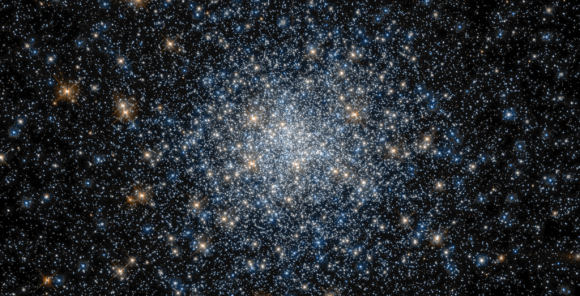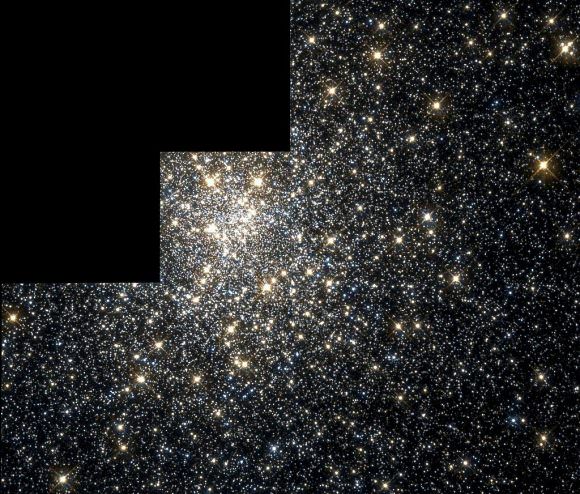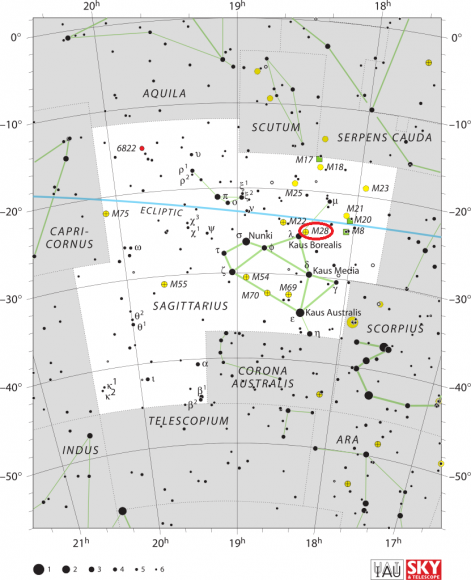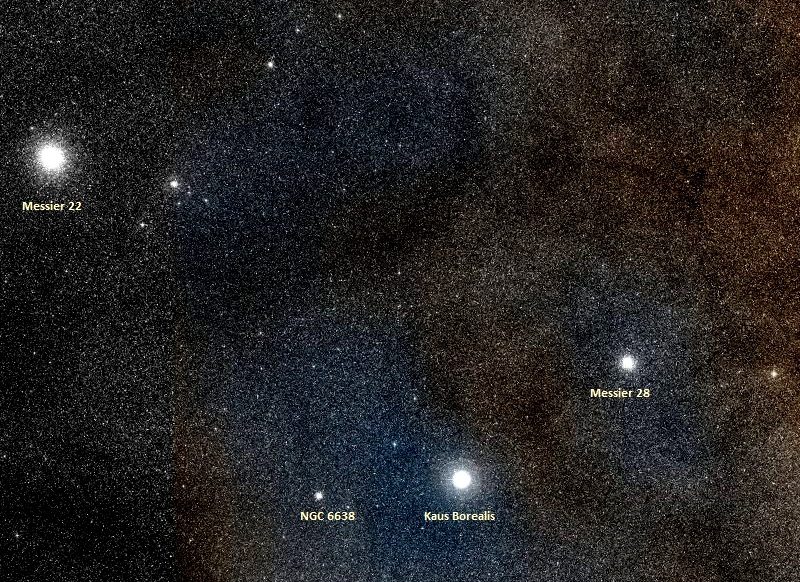Welcome back to Messier Monday! In our ongoing tribute to the great Tammy Plotner, we take a look at the Globular Cluster known as Messier 28. Enjoy!
Back in the 18th century, famed French astronomer Charles Messier noted the presence of several “nebulous objects” in the night sky. Having originally mistaken them for comets, he began compiling a list of them so that others would not make the same mistake he did. In time, this list would come to include 100 of the most fabulous objects in the night sky.
One of these objects was the globular cluster now known as Messier 28. Located in the direction of the Sagittarius constellation, some 17,900 light-years from Earth, this “nebulous” cluster is easily detectable in the night sky. It is also the third largest known clustering of millisecond pulsars in the known Universe.
Description:
Compressed into a sphere measuring about 60 light years in diameter, globular star cluster Messier 28 happily orbits our galactic center about 19,000 light years away from Earth. In all of its thousands upon thousands of stars, M28 contains 18 known RR Lyrae variables and a W Virginis variable star. This very different variable is a Type II, or population II Cepheid that has a precise change rate which occurs every 17 days.

There has also been a second long period variable discovered, which could very well be an RV Tauri type, too. However, one of M28’s biggest claims to fame happened in 1986, when it became the first globular cluster known to contain a millisecond pulsar. This was discovered by the Lovell Telescope at Jodrell Bank Observatory. The work on the pulsar was later picked up by Chandra researchers.
As Martin C. Weisskopf (et al) of the Space Sciences Department put it in a 2002 study of the object:
“We report here the results of the first Chandra X-Ray Observatory observations of the globular cluster M28 (NGC 6626). We detect 46 X-ray sources of which 12 lie within one core radius of the center. We measure the radial distribution of the X-ray sources and fit it to a King profile finding a core radius. We measure for the first time the unconfused phase-averaged X-ray spectrum of the 3.05-ms pulsar B1821–24 and find it is best described by a power law with photon index. We find marginal evidence of an emission line centered at 3.3 keV in the pulsar spectrum, which could be interpreted as cyclotron emission from a corona above the pulsar’s polar cap if the magnetic field is strongly different from a centered dipole. We present a spectral analyses of the brightest unidentified source and suggest that it is a transiently accreting neutron star in a low-mass X-ray binary, in quiescence. In addition to the resolved sources, we detect fainter, unresolved X-ray emission from the central core.”
And the search has far from ended as even more X-ray counterparts have been discovered inside this seemingly quiet globular cluster! As W. Becker and C.Y. Hui of the Max Planck Institute wrote in their 2007 study:
“A recent radio survey of globular clusters has increased the number of millisecond pulsars drastically. M28 is now the globular cluster with the third largest population of known pulsars, after Terzan 5 and 47 Tuc. This prompted us to revisit the archival Chandra data on M28 to evaluate whether the newly discovered millisecond pulsars find a counterpart among the various X-ray sources detected in M28 previously. The radio position of PSR J1824-2452H is found to be in agreement with the position of CXC 182431-245217 while some faint unresolved X-ray emission near to the center of M28 is found to be coincident with the millisecond pulsars PSR J1824-2452G, J1824-2452J, J1824-2452I and J1824-2452E.”

So is it possible that these can be seen? According to the 2001 study – “A search for the optical counterpart to PSR B1821-24 in M 28” – by Hubble researcher A Golden (et al.):
“We have analyzed archival HST/WFPC2 images in both the F555W & F814W bands of the core field of the globular cluster M 28 in an attempt to identify the optical counterpart of the magnetospherically active millisecond pulsar PSR B1821-24. Examination of the radio derived error circle yielded several potential candidates, down to a magnitude of V
24.5 (V0
23.0). Each were further investigated, both in the context of the CMD of M 28, and also with regard to phenomenological models of pulsar magnetospheric emission. The latter was based on both luminosity-spindown correlations and known spectral flux density behaviour in this regime from the small population of optical pulsars observed to date. None of the potential candidates exhibited emission expected from a magnetospherically active pulsar. The fact that the magnetic field & spin coupling for PSR B1821-24 is of a similar magnitude to that of the Crab pulsar in the vicinity of the light cylinder has suggested that the millisecond pulsar may well be an efficient nonthermal emitter. ASCA’s detection of a strong synchrotron-dominated X-ray pulse fraction encourages such a viewpoint. We argue that only future dedicated 2-d high speed photometry observations of the radio error-circle can finally resolve this matter.”
History of Observation:
This globular cluster was an original discovery in July 1764 of Charles Messier who wrote in his notes:
“In the night of the 26th to the 27th of the same month, I have discovered a nebula in the upper part of the bow of Sagittarius, at about 1 degree from the star Lambda of that constellation, and little distant from the beautiful nebula which is between the head and the bow: that new one may be the third of the older one, and doesn’t contain any star, as far as I have been able to judge when examining it with a good Gregorian telescope which magnifies 104 times: it is round, its diameter is about 2 minutes of arc; one sees it with difficulty with an ordinary refractor of 3 feet and a half of length. I have compared the middle with the star Lambda Sagittarii, and I have concluded its right ascension of 272d 29′ 30″, and its declination of 37d 11′ 57″ south.”
As always, Sir William Herschel would often revisit with Messier’s objects for his own private observations and in his notes he states:
“It may be called insulated though situated in a part of the heavens that is very rich in stars. It may have a nucleus, for it is much compressed towards the centre, and the situation is too low for seeing it well. The stars of the cluster are pretty numerous.” It would be his son, John Herschel who would give M28 its New General Catalog Number and describe it as “Not very bright; but very rich, excessively compressed globular cluster; stars of 14th to 15th magnitude; much brighter toward the middle; a fine object.”

Regardless of whether or not you use binoculars or a telescope on M28, part of the joy of this object is understand how very rich the stellar field is in which it appears. As John Herschel once said of M28 in his many observations, “Occurs in the milky way, of which the stars here are barely visible and immensely numerous.”
Locating Messier 28:
Finding M28 is another easy object once you’ve familiarized yourself with the “teapot” asterism of the constellation of Sagittarius. In binoculars, simply center Lambda in the field of view and you will see Messier 28 as a small, faded grey circular area in the 1:00 position away from the marker star.
In the finderscope of telescope, you can start by centering on Lambda and go to the eyepiece and simply shift the telescope to the northwest slowly and Messier 28 will pop into view. While this globular cluster is easily bright enough to be seen in the smallest of optics, it will require at least a 4″ telescope before it begins any resolution of individual stars and telescopes in the 10″ and larger range will fully appreciate all it has to offer.
And here are the quick facts to help you get started:
Object Name: Messier 28
Alternative Designations: M28, NGC 6626
Object Type: Class IV Globular Cluster
Constellation: Sagittarius
Right Ascension: 18 : 24.5 (h:m)
Declination: -24 : 52 (deg:m)
Distance: 18.3 (kly)
Visual Brightness: 6.8 (mag)
Apparent Dimension: 11.2 (arc min)
We have written many interesting articles about Messier Objects here at Universe Today. Here’s Tammy Plotner’s Introduction to the Messier Objects, , M1 – The Crab Nebula, M8 – The Lagoon Nebula, and David Dickison’s articles on the 2013 and 2014 Messier Marathons.
Be to sure to check out our complete Messier Catalog. And for more information, check out the SEDS Messier Database.
Sources:

